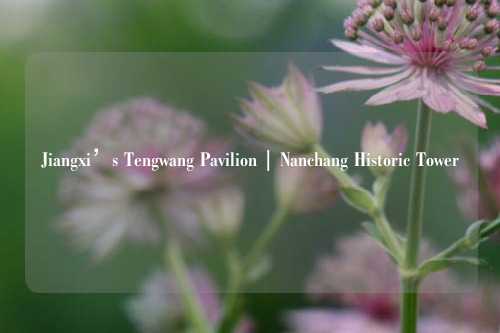Jiangxi’s Tengwang Pavilion | Nanchang Historic Tower
Tengwang Pavilion: A Historic Symbol of Jiangxi
Tengwang Pavilion, located in Nanchang, the capital city of Jiangxi Province, stands as one of China’s most significant and historical architectural landmarks. Overlooking the scenic Gan River, this ancient pavilion offers a glimpse into the grandeur of traditional Chinese design and cultural significance. Originally constructed in 653 AD during the Tang Dynasty, the pavilion has experienced several reconstructions and restorations, maintaining its position as a prominent symbol of Jiangxi’s rich history.
The structure is widely recognized for its historical importance and its association with the famous poet Wang Bo, whose work “Preface to Tengwang Pavilion” became one of the most celebrated pieces of Chinese literature. This classical text, written during the Tang Dynasty, describes the pavilion's beauty and grandeur, cementing the structure’s place in Chinese literary and cultural history. Today, Tengwang Pavilion stands not only as a beacon of Jiangxi's architectural heritage but also as a hub for cultural tourism and historical exploration.

A Monument of Architectural Excellence
The Tengwang Pavilion is a masterpiece of ancient Chinese architecture. With its grand and elaborate design, the pavilion’s multi-story structure exemplifies traditional Chinese architectural principles. The building incorporates a harmonious blend of wooden beams, intricately carved windows, and sloping roofs adorned with colorful tiles. The elegant curvature of the roof combined with the towering structure makes Tengwang Pavilion a distinctive and imposing presence against the skyline of Nanchang.
The pavilion is built using the typical ancient Chinese design of a multi-tiered wooden structure, with each floor offering a unique view of the surrounding landscape. Its wooden beams and carved windows showcase the craftsmanship of ancient builders, highlighting the importance of structural design in Chinese architecture. The structure has gone through several reconstructions throughout the years, yet it still retains the essence of its original Tang Dynasty design. As a result, Tengwang Pavilion offers an exceptional opportunity to experience a living piece of Chinese architectural history.
The wooden structure’s open balconies provide a perfect viewing platform, offering sweeping vistas of the Gan River and Nanchang city. The building is not only an architectural gem but also a place where visitors can experience a sense of connection with the past, as it has witnessed centuries of change and cultural development in China.
Cultural Significance and Literary Connections
Tengwang Pavilion is famously linked to the literary figure Wang Bo, whose "Preface to Tengwang Pavilion" is one of the cornerstones of Chinese literature. Wang Bo’s writing immortalizes the pavilion and its surroundings, making it a key cultural symbol in Chinese history. The preface describes the pavilion in vivid detail, highlighting both its grandeur and the serene beauty of the surrounding landscape, while also reflecting on the transient nature of life and the impermanence of human achievements.
This literary connection has greatly enhanced the cultural value of the pavilion, attracting scholars, poets, and writers who come to reflect on the themes of Wang Bo's work. The pavilion itself is often referred to as a literary monument, bridging the realms of architecture, poetry, and history. Visitors to Tengwang Pavilion can engage with this rich cultural backdrop by exploring the many inscriptions and poems found on the walls of the pavilion, which reflect the thoughts of past scholars and poets.
Over the centuries, Tengwang Pavilion has also been a symbol of Nanchang’s cultural identity and a gathering place for intellectuals and officials. It stands as a testament to the city’s enduring historical significance as a center of learning and cultural exchange.
The Scenic Beauty Surrounding Tengwang Pavilion
One of the most striking features of Tengwang Pavilion is its picturesque location along the Gan River. The pavilion offers sweeping views of the river and the surrounding city, making it a prime spot for visitors to take in the natural beauty of Nanchang. The river, with its winding path and peaceful waters, contrasts with the architectural splendor of the pavilion, creating a serene environment that has captivated visitors for centuries.
The pavilion is particularly breathtaking during sunset and sunrise, when the light reflects off the river and illuminates the structure in a golden glow. The scenic views from the upper floors provide visitors with a unique opportunity to appreciate both the beauty of the pavilion itself and the surrounding landscape. The area around the pavilion is also home to lush green spaces and trees, adding to the overall tranquility of the site.
In addition to the natural beauty, the surrounding area has been developed into a cultural and recreational space, with walking paths and gardens that allow visitors to enjoy the environment in a relaxed manner. The peaceful ambiance of the area invites guests to stroll leisurely and appreciate the harmony between the natural landscape and the grand architectural structure.
Tengwang Pavilion: A Symbol of Resilience
Throughout its long history, Tengwang Pavilion has faced multiple challenges, including several periods of destruction and reconstruction. The original pavilion was destroyed during wars and conflicts, only to be rebuilt and restored to its former glory. Each reconstruction has contributed to the preservation of the pavilion as a symbol of resilience and the enduring strength of Chinese culture.
The modern-day Tengwang Pavilion stands as a tribute to both the past and the future. The structure, while being a faithful reconstruction of the original, incorporates modern techniques to ensure its stability and preservation. The pavilion's continued restoration efforts highlight the importance of maintaining cultural heritage while adapting to the needs of contemporary society.
Visiting Tengwang Pavilion today, one is reminded not only of the ancient history it embodies but also of the collective efforts that have gone into preserving this iconic landmark for future generations. The structure’s survival through centuries of change and turmoil serves as a symbol of endurance and the timeless value of cultural landmarks.
A Place for Reflection and Inspiration
Tengwang Pavilion has long been a place for reflection and inspiration, particularly for those who seek to explore the intersection of history, culture, and literature. The pavilion’s role in Chinese literature, especially through the works of Wang Bo, has made it a site of pilgrimage for literature lovers and scholars. It serves as both a muse for creative expression and a place of intellectual reflection.
Visitors often take the opportunity to explore the pavilion’s halls and take in the historical inscriptions, poems, and writings that line the walls. These words, etched into the wood, capture the wisdom and creativity of the poets and scholars who have visited the pavilion over the centuries. The words of Wang Bo and other renowned writers echo through the halls, offering visitors a deep connection to the past and an appreciation for the literary tradition that has shaped the history of Jiangxi and China as a whole.
In addition to its literary significance, Tengwang Pavilion also provides visitors with a chance to reflect on the impermanence of life and the passage of time. The view from the pavilion, with the river winding through the city and the distant mountains looming in the background, invites contemplation and introspection, providing a peaceful space for visitors to connect with both their surroundings and their inner thoughts.
The Pavilion as a Gateway to Nanchang’s History
Tengwang Pavilion is not only a symbol of Jiangxi’s cultural and architectural history but also serves as a gateway to the broader historical context of Nanchang. As one of the oldest cities in southern China, Nanchang has a long and storied past that spans thousands of years. The pavilion provides visitors with a tangible connection to this history, offering a window into the city’s cultural evolution and the pivotal role it has played in the development of Chinese civilization.
Located near the heart of Nanchang, Tengwang Pavilion is easily accessible from other historical sites in the city, making it an ideal starting point for exploring the region’s rich heritage. Visitors can easily extend their exploration to nearby sites such as the Nanchang Uprising Memorial Museum, which commemorates the city’s role in the 1927 uprising that was a key event in Chinese revolutionary history.
Through its association with both ancient and modern history, Tengwang Pavilion continues to serve as an important cultural and historical landmark that connects the past with the present, offering visitors a deeper understanding of Jiangxi and Nanchang's place in China's rich tapestry of history.
Preserving a Cultural Heritage for Future Generations
As with many historic landmarks in China, the preservation of Tengwang Pavilion is of utmost importance. The ongoing efforts to maintain the pavilion's architectural integrity, along with its rich literary and cultural heritage, ensure that future generations will have the opportunity to experience this monumental structure. Preservation efforts focus not only on the physical structure but also on maintaining the cultural significance that the pavilion holds for Chinese society.
Through careful restoration and continued education about its historical and cultural importance, Tengwang Pavilion will remain a beacon of Jiangxi’s past and a source of inspiration for future generations. As a place where history, literature, and architecture converge, the pavilion stands as a reminder of the enduring power of cultural heritage and its ability to inspire those who visit it.
















